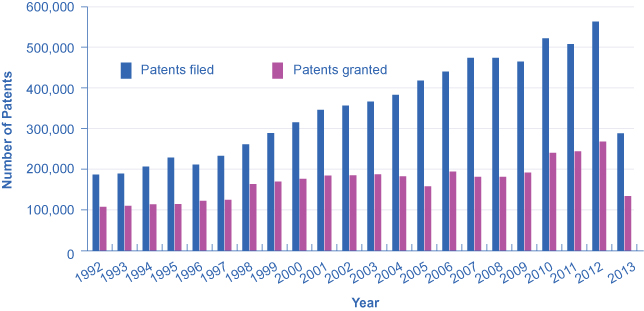| << Chapter < Page | Chapter >> Page > |
A number of different government policies can increase the incentives to innovate, including: guaranteeing intellectual property rights, government assistance with the costs of research and development, and cooperative research ventures between universities and companies.
One way to increase new technology is to guarantee the innovator an exclusive right to that new product or process. Intellectual property rights include patents, which give the inventor the exclusive legal right to make, use, or sell the invention for a limited time, and copyright laws, which give the author an exclusive legal right over works of literature, music, film/video, and pictures. For example, if a pharmaceutical firm has a patent on a new drug, then no other firm can manufacture or sell that drug for twenty-one years, unless the firm with the patent grants permission. Without a patent, the pharmaceutical firm would have to face competition for any successful products, and could earn no more than a normal rate of profit. With a patent, a firm is able to earn monopoly profits on its product for a period of time—which offers an incentive for research and development. In general, how long can “a period of time” be? The Clear it Up discusses patent and copyright protection timeframes for some works you might have heard of.
All patents and copyrights are scheduled to end someday. In 2003, copyright protection for Mickey Mouse was scheduled to run out. Once the copyright had expired, anyone would be able to copy Mickey Mouse cartoons or draw and sell new ones. In 1998, however, Congress passed the Sonny Bono Copyright Term Extension Act. For copyrights owned by companies or other entities, it increased or extended the copyright from 75 years to 95 years after publication. For copyrights owned by individuals, it increased or extended the copyright coverage from 50 years to 70 years after death. Along with protecting Mickey for another 20 years, the copyright extension affected about 400,000 books, movies, and songs.
[link] illustrates how the total number of patent applications filed with the U.S. Patent and Trademark Office, as well as the total number of patents granted, surged in the mid-1990s with the invention of the Internet, and is still going strong today.

While patents provide an incentive to innovate by protecting the innovator, they are not perfect. For example:

Notification Switch
Would you like to follow the 'Principles of economics' conversation and receive update notifications?